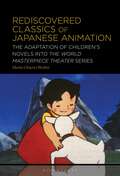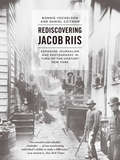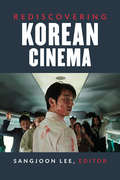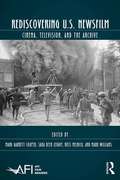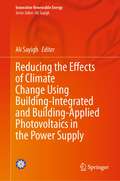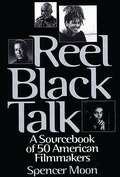- Table View
- List View
Redesigning the Unremarkable
by Evonne Miller Debra Flanders CushingRedesigning the Unremarkable is a timely and necessary reminder that the often neglected elements and spaces of our built environment – from trash bins, seats, stairways, and fences to streets, bikeways, underpasses, parking lots, and shopping centres – must be thoughtfully redesigned to enhance human and planetary health. Using the lens of sustainable, salutogenic, and playable design, in this inspiring book, Miller and Cushing explore the challenges, opportunities, and importance of redesigning the unremarkable. Drawing on global research, theory, practical case studies, photographs, and personal experiences, Redesigning the Unremarkable is a vital text – a doer’s guide – for researchers, policymakers, and practitioners wanting to transform and positively reimagine our urban environment.
Redesigning the Unremarkable
by Evonne Miller Debra Flanders CushingRedesigning the Unremarkable is a timely and necessary reminder that the often neglected elements and spaces of our built environment – from trash bins, seats, stairways, and fences to streets, bikeways, underpasses, parking lots, and shopping centres – must be thoughtfully redesigned to enhance human and planetary health. Using the lens of sustainable, salutogenic, and playable design, in this inspiring book, Miller and Cushing explore the challenges, opportunities, and importance of redesigning the unremarkable. Drawing on global research, theory, practical case studies, photographs, and personal experiences, Redesigning the Unremarkable is a vital text – a doer’s guide – for researchers, policymakers, and practitioners wanting to transform and positively reimagine our urban environment.
Redeveloping Industrial Sites: A Guide for Architects, Planners, and Developers
by Carol BerensThe ultimate resource on strategies for redeveloping abandoned urban sites Architects, urban planners, urban designers, developers, city officials, and all those interested in revitalizing their post-industrial cities will find the tools they need here. Redeveloping Industrial Sites delivers solutions to complex issues concerning urban planning, design, and financing to reveal lessons on ways to successfully convert decaying land and buildings into vibrant parks, stimulating cultural destinations, and active commercial complexes. In addition, carefully chosen real-world examples illustrate topics such as sustainability, public policy, and developer know-how to form a complete picture of the elements involved in planning and executing urban redevelopment projects. Redeveloping Industrial Sites: Covers strategies used to turn abandoned industrial sites into vibrant new neighborhoods and special districts such as Toronto's Distillery District and Philadelphia's Piazza at Schmidts Emphasizes design and economic issues that urban planners and city officials need to plan successful projects as well as manage spontaneous neighborhood transformations such as loft conversions Includes case studies of a variety of redevelopments from across North America and Europe ranging from large projects such as New York's Hudson River Park and Amsterdam's harbor to the small, but important neighborhood regenerators such as Baltimore's American Brewery Building for Humanim Examines how cities from Minneapolis, Minnesota to North Adams, Massachusetts, to Swansea, Wales harnessed the forces of tourism and art to transform their mills and harbors Providing historical context as well as current perspective, Redeveloping Industrial Sites offers clear direction on repurposing derelict and polluted wastelands and warehouses into vital, living extensions of their communities.
Redeveloping Industrial Sites: A Guide for Architects, Planners, and Developers
by Carol BerensThe ultimate resource on strategies for redeveloping abandoned urban sites Architects, urban planners, urban designers, developers, city officials, and all those interested in revitalizing their post-industrial cities will find the tools they need here. Redeveloping Industrial Sites delivers solutions to complex issues concerning urban planning, design, and financing to reveal lessons on ways to successfully convert decaying land and buildings into vibrant parks, stimulating cultural destinations, and active commercial complexes. In addition, carefully chosen real-world examples illustrate topics such as sustainability, public policy, and developer know-how to form a complete picture of the elements involved in planning and executing urban redevelopment projects. Redeveloping Industrial Sites: Covers strategies used to turn abandoned industrial sites into vibrant new neighborhoods and special districts such as Toronto's Distillery District and Philadelphia's Piazza at Schmidts Emphasizes design and economic issues that urban planners and city officials need to plan successful projects as well as manage spontaneous neighborhood transformations such as loft conversions Includes case studies of a variety of redevelopments from across North America and Europe ranging from large projects such as New York's Hudson River Park and Amsterdam's harbor to the small, but important neighborhood regenerators such as Baltimore's American Brewery Building for Humanim Examines how cities from Minneapolis, Minnesota to North Adams, Massachusetts, to Swansea, Wales harnessed the forces of tourism and art to transform their mills and harbors Providing historical context as well as current perspective, Redeveloping Industrial Sites offers clear direction on repurposing derelict and polluted wastelands and warehouses into vital, living extensions of their communities.
Rediscovered Classics of Japanese Animation: The Adaptation of Children’s Novels into the World Masterpiece Theater Series
by Maria Chiara OltoliniRediscovered Classics of Japanese Animation is the first academic work to examine World Masterpiece Theater (Sekai Meisaku Gekijô, 1969-2009), which popularized the practice of adapting foreign children's books into long-running animated series and laid the groundwork for powerhouses like Studio Ghibli.World Masterpiece Theater (Sekai Meisaku Gekijô, 1969-2009) is a TV staple created by the Japanese studio Nippon Animation, which popularized the practice of adapting foreign children's books into long-running animated series. Once generally dismissed by critics, the series is now frequently investigated as a key early work of legendary animators Isao Takahata and Hayao Miyazaki. In the first book-length examination of the series, Maria Chiara Olitini analyzes cultural significance of World Masterpiece Theater, and the ways in which the series pioneered the importance of children's fiction for Japanese animation studios and laid the groundwork for powerhouses like Studio Ghibli.Adapting a novel for animation also means decoding (and re-coding) socio-cultural patterns embedded in a narrative. World Masterpiece Theater stands as a unique example of this linguistic, medial, and cultural hybridisation. Popular children's classics such as Little Women, Peter Pan, and Anne of Green Gables became the starting point of a full-fledged negotiation process in which Japanese animators retold a whole range of narratives that have one basic formula in common: archetypal stories with an educational purpose. In particular, the series played a role in shaping the pop culture image of a young girl (shôjo).Examining the series through the lens of animation studies as well as adaptation studies, Olitini sheds new light on this long-neglected staple of Japanese animation history.
Rediscovered Classics of Japanese Animation: The Adaptation of Children’s Novels into the World Masterpiece Theater Series
by Maria Chiara OltoliniRediscovered Classics of Japanese Animation is the first academic work to examine World Masterpiece Theater (Sekai Meisaku Gekijô, 1969-2009), which popularized the practice of adapting foreign children's books into long-running animated series and laid the groundwork for powerhouses like Studio Ghibli.World Masterpiece Theater (Sekai Meisaku Gekijô, 1969-2009) is a TV staple created by the Japanese studio Nippon Animation, which popularized the practice of adapting foreign children's books into long-running animated series. Once generally dismissed by critics, the series is now frequently investigated as a key early work of legendary animators Isao Takahata and Hayao Miyazaki. In the first book-length examination of the series, Maria Chiara Olitini analyzes cultural significance of World Masterpiece Theater, and the ways in which the series pioneered the importance of children's fiction for Japanese animation studios and laid the groundwork for powerhouses like Studio Ghibli.Adapting a novel for animation also means decoding (and re-coding) socio-cultural patterns embedded in a narrative. World Masterpiece Theater stands as a unique example of this linguistic, medial, and cultural hybridisation. Popular children's classics such as Little Women, Peter Pan, and Anne of Green Gables became the starting point of a full-fledged negotiation process in which Japanese animators retold a whole range of narratives that have one basic formula in common: archetypal stories with an educational purpose. In particular, the series played a role in shaping the pop culture image of a young girl (shôjo).Examining the series through the lens of animation studies as well as adaptation studies, Olitini sheds new light on this long-neglected staple of Japanese animation history.
Rediscovering Jacob Riis: Exposure Journalism and Photography in Turn-of-the-Century New York
by Bonnie Yochelson Daniel CzitromBefore publishing his pioneering book How the Other Half Lives—a photojournalistic investigation into the poverty of New York’s tenement houses, home to three quarters of the city’s population—Jacob Riis (1849-1914) spent his first years in the United States as an immigrant and itinerant laborer, barely surviving on his carpentry skills until he landed a job as a muckraking reporter. These early experiences provided Riis with an understanding of what it was like to be poor in the immigrant communities that populated New York’s slums, and it was this empathy that would shine through in his iconic photos. With Rediscovering Jacob Riis, art historian Bonnie Yochelson and historian Daniel Czitrom place Jacob Riis’s images in historical context even as they expose a clear sightline to the present. In the first half of their book, Czitrom explores Riis’s reporting and activism within the gritty specifics of Gilded Age New York: its new immigrants, its political machines, its fiercely competitive journalism, its evangelical reformers, and its labor movement. In delving into Riis’s intellectual education and the lasting impact of How the Other Half Lives, Czitrom shows that though Riis argued for charity, not sociopolitical justice, the empathy that drove his work continues to inspire urban reformers today. In the second half of the book, Yochelson describes for the first time Riis’s photographic practice: his initial reliance on amateur photographers to take the photographs he needed, his own use of the camera, and then his collecting of photographs by professionals, who by 1900 were documenting social reform efforts for government agencies and charities. She argues that while Riis is rightly considered a revolutionary in the history of photography, he was not a photographic artist. Instead, Riis was a writer and lecturer who first harnessed the power of photography to affect social change. As staggering inequality continues to be an urgent political topic, this book, illustrated with nearly seventy of Riis’s photographs, will serve as a stunning reminder of what has changed, and what has not.
Rediscovering Jacob Riis: Exposure Journalism and Photography in Turn-of-the-Century New York
by Bonnie Yochelson Daniel CzitromBefore publishing his pioneering book How the Other Half Lives—a photojournalistic investigation into the poverty of New York’s tenement houses, home to three quarters of the city’s population—Jacob Riis (1849-1914) spent his first years in the United States as an immigrant and itinerant laborer, barely surviving on his carpentry skills until he landed a job as a muckraking reporter. These early experiences provided Riis with an understanding of what it was like to be poor in the immigrant communities that populated New York’s slums, and it was this empathy that would shine through in his iconic photos. With Rediscovering Jacob Riis, art historian Bonnie Yochelson and historian Daniel Czitrom place Jacob Riis’s images in historical context even as they expose a clear sightline to the present. In the first half of their book, Czitrom explores Riis’s reporting and activism within the gritty specifics of Gilded Age New York: its new immigrants, its political machines, its fiercely competitive journalism, its evangelical reformers, and its labor movement. In delving into Riis’s intellectual education and the lasting impact of How the Other Half Lives, Czitrom shows that though Riis argued for charity, not sociopolitical justice, the empathy that drove his work continues to inspire urban reformers today. In the second half of the book, Yochelson describes for the first time Riis’s photographic practice: his initial reliance on amateur photographers to take the photographs he needed, his own use of the camera, and then his collecting of photographs by professionals, who by 1900 were documenting social reform efforts for government agencies and charities. She argues that while Riis is rightly considered a revolutionary in the history of photography, he was not a photographic artist. Instead, Riis was a writer and lecturer who first harnessed the power of photography to affect social change. As staggering inequality continues to be an urgent political topic, this book, illustrated with nearly seventy of Riis’s photographs, will serve as a stunning reminder of what has changed, and what has not.
Rediscovering Jacob Riis: Exposure Journalism and Photography in Turn-of-the-Century New York
by Bonnie Yochelson Daniel CzitromBefore publishing his pioneering book How the Other Half Lives—a photojournalistic investigation into the poverty of New York’s tenement houses, home to three quarters of the city’s population—Jacob Riis (1849-1914) spent his first years in the United States as an immigrant and itinerant laborer, barely surviving on his carpentry skills until he landed a job as a muckraking reporter. These early experiences provided Riis with an understanding of what it was like to be poor in the immigrant communities that populated New York’s slums, and it was this empathy that would shine through in his iconic photos. With Rediscovering Jacob Riis, art historian Bonnie Yochelson and historian Daniel Czitrom place Jacob Riis’s images in historical context even as they expose a clear sightline to the present. In the first half of their book, Czitrom explores Riis’s reporting and activism within the gritty specifics of Gilded Age New York: its new immigrants, its political machines, its fiercely competitive journalism, its evangelical reformers, and its labor movement. In delving into Riis’s intellectual education and the lasting impact of How the Other Half Lives, Czitrom shows that though Riis argued for charity, not sociopolitical justice, the empathy that drove his work continues to inspire urban reformers today. In the second half of the book, Yochelson describes for the first time Riis’s photographic practice: his initial reliance on amateur photographers to take the photographs he needed, his own use of the camera, and then his collecting of photographs by professionals, who by 1900 were documenting social reform efforts for government agencies and charities. She argues that while Riis is rightly considered a revolutionary in the history of photography, he was not a photographic artist. Instead, Riis was a writer and lecturer who first harnessed the power of photography to affect social change. As staggering inequality continues to be an urgent political topic, this book, illustrated with nearly seventy of Riis’s photographs, will serve as a stunning reminder of what has changed, and what has not.
Rediscovering Jacob Riis: Exposure Journalism and Photography in Turn-of-the-Century New York
by Bonnie Yochelson Daniel CzitromBefore publishing his pioneering book How the Other Half Lives—a photojournalistic investigation into the poverty of New York’s tenement houses, home to three quarters of the city’s population—Jacob Riis (1849-1914) spent his first years in the United States as an immigrant and itinerant laborer, barely surviving on his carpentry skills until he landed a job as a muckraking reporter. These early experiences provided Riis with an understanding of what it was like to be poor in the immigrant communities that populated New York’s slums, and it was this empathy that would shine through in his iconic photos. With Rediscovering Jacob Riis, art historian Bonnie Yochelson and historian Daniel Czitrom place Jacob Riis’s images in historical context even as they expose a clear sightline to the present. In the first half of their book, Czitrom explores Riis’s reporting and activism within the gritty specifics of Gilded Age New York: its new immigrants, its political machines, its fiercely competitive journalism, its evangelical reformers, and its labor movement. In delving into Riis’s intellectual education and the lasting impact of How the Other Half Lives, Czitrom shows that though Riis argued for charity, not sociopolitical justice, the empathy that drove his work continues to inspire urban reformers today. In the second half of the book, Yochelson describes for the first time Riis’s photographic practice: his initial reliance on amateur photographers to take the photographs he needed, his own use of the camera, and then his collecting of photographs by professionals, who by 1900 were documenting social reform efforts for government agencies and charities. She argues that while Riis is rightly considered a revolutionary in the history of photography, he was not a photographic artist. Instead, Riis was a writer and lecturer who first harnessed the power of photography to affect social change. As staggering inequality continues to be an urgent political topic, this book, illustrated with nearly seventy of Riis’s photographs, will serve as a stunning reminder of what has changed, and what has not.
Rediscovering Korean Cinema (Perspectives On Contemporary Korea)
by Sangjoon LeeSouth Korean cinema is a striking example of non-Western contemporary cinematic success. Thanks to the increasing numbers of moviegoers and domestic films produced, South Korea has become one of the world’s major film markets. In 2001, the South Korean film industry became the first in recent history to reclaim its domestic market from Hollywood and continues to maintain around a 50 percent market share today. High-quality South Korean films are increasingly entering global film markets and connecting with international audiences in commercial cinemas and art theatres, and at major international film festivals. Despite this growing recognition of the films themselves, Korean cinema’s rich heritage has not heretofore received significant scholarly attention in English-language publications. This groundbreaking collection of thirty-five essays by a wide range of academic specialists situates current scholarship on Korean cinema within the ongoing theoretical debates in contemporary global film studies. Chapters explore key films of Korean cinema, from Sweet Dream, Madame Freedom, The Housemaid, and The March of Fools to Oldboy, The Host, and Train to Busan, as well as major directors such as Shin Sang-ok, Kim Ki-young, Im Kwon-taek, Bong Joon-ho, Hong Sang-soo, Park Chan-wook, and Lee Chang-dong. While the chapters provide in-depth analyses of particular films, together they cohere into a detailed and multidimensional presentation of Korean cinema’s cumulative history and broader significance. With its historical and critical scope, abundance of new research, and detailed discussion of important individual films, Rediscovering Korean Cinema is at once an accessible classroom text and a deeply informative compendium for scholars of Korean and East Asian studies, cinema and media studies, and communications. It will also be an essential resource for film industry professionals and anyone interested in international cinema.
Rediscovering Objects from Islamic Lands in Enlightenment Europe (Studies in Art Historiography)
by Isabelle DolezalekThis book argues that the provenance of early modern and medieval objects from Islamic lands was largely forgotten until the "long" eighteenth century, when the first efforts were made to reconnect them with the historical contexts in which they were produced. For the first time, these Islamicate objects were read, studied and classified – and given a new place in history. Freed by scientific interest, they were used in new ways and found new homes, including in museums. More generally, the process of "rediscovery" opened up the prehistory of the discipline of Islamic art history and had a significant impact on conceptions of cultural boundaries, differences and identity. The book will be of interest to scholars working in the history of art, the art of the Islamic world, early modern history and art historiography.
Rediscovering Objects from Islamic Lands in Enlightenment Europe (Studies in Art Historiography)
by Isabelle Dolezalek Mattia GuidettiThis book argues that the provenance of early modern and medieval objects from Islamic lands was largely forgotten until the "long" eighteenth century, when the first efforts were made to reconnect them with the historical contexts in which they were produced. For the first time, these Islamicate objects were read, studied and classified – and given a new place in history. Freed by scientific interest, they were used in new ways and found new homes, including in museums. More generally, the process of "rediscovery" opened up the prehistory of the discipline of Islamic art history and had a significant impact on conceptions of cultural boundaries, differences and identity. The book will be of interest to scholars working in the history of art, the art of the Islamic world, early modern history and art historiography.
Rediscovering the Great Plains: Journeys by Dog, Canoe, and Horse (Creating the North American Landscape)
by Norman Scott HendersonThe North American Plains are one of the world's great landscapes—perhaps the signature landscape of the continent. Today, the most intimate experience most of us have of the great grasslands is from behind the window of a car or train. It was not always so. In the earliest days, Plains Indians traveled on foot across the vastness, with only the fierce, wolflike Plains dogs as companions. Later, with the arrival of the Europeans, horses and canoes appeared on the Plains. In Rediscovering the Great Plains, Norman Henderson, a leading scholar of the world's great temperate grasslands, revives these traditional modes of travel, journeying along 200 miles of Canada's Qu'Appelle River valley by dog and travois (the wooden rack pulled by dogs and horses used by Native Americans to transport goods), then by canoe, and finally by horse and travois.Henderson interweaves his own adventures with the exploits of earlier Plains travelers, like Lewis and Clark, Francisco Coronado, La Vérendrye, and Alexander Henry. Lesser-known experiences of the fur traders and others who struggled to cross this strange and forbidding landscape also illuminate the story, while Henderson's often humorous description of his attempts to find and train old Plains breeds of dogs and horses highlight the difficulties involved in recreating archaic travel methods. He also draws on the history of the world's other great temperate grasslands: the South American pampas and the Eurasian steppes. Recalling the work of Ian Frazier and Jonathan Raban, Henderson's captivating account of his three journeys of exploration will foster a better appreciation for, and deeper understanding of, the natural and human history of the North American Plains.
Rediscovering U.S. Newsfilm: Cinema, Television, and the Archive (AFI Film Readers)
by Mark Garrett Cooper Sara Beth Levavy Ross Melnick Mark WilliamsThe twentieth century generated tens of thousands of hours of American newsfilm but not the scholarly apparatus necessary to analyze and contextualize them. Assembling new approaches to the study of U.S. newsfilm in cinema and television, this book makes a long overdue critical intervention in the field of film and media studies by addressing the format’s inherent intermediality; its mediation of "events" for local, national, and transnational communities; its distinctive archival legacies; and, consequently, its integral place in film and television studies more broadly. This collection brings fresh, contemporary methodologies and analysis to bear on a vast amount of material that has languished in relative obscurity for far too long.
Rediscovering U.S. Newsfilm: Cinema, Television, and the Archive (AFI Film Readers)
by Mark Garrett Cooper Sara Beth Levavy Ross Melnick Mark WilliamsThe twentieth century generated tens of thousands of hours of American newsfilm but not the scholarly apparatus necessary to analyze and contextualize them. Assembling new approaches to the study of U.S. newsfilm in cinema and television, this book makes a long overdue critical intervention in the field of film and media studies by addressing the format’s inherent intermediality; its mediation of "events" for local, national, and transnational communities; its distinctive archival legacies; and, consequently, its integral place in film and television studies more broadly. This collection brings fresh, contemporary methodologies and analysis to bear on a vast amount of material that has languished in relative obscurity for far too long.
Rediscovery of Cultural Landscapes in Southern China: Sustainable Heritage and Planning in Rural Settlements (Planning, Heritage and Sustainability)
by Wallace P.H. ChangThis book investigates the concept of human landscape in rural settlements in Southern China, where communities and their cultural landscapes are facing contemporary challenges following a period of rapid urbanization in the last 50 years. While metropolitan cities, such as Hong Kong, are experiencing accelerated urban development, underpopulated rural villages are struggling to maintain the cultural heritage of their regions. Rediscovery of Cultural Landscapes in Southern China provides a detailed account into indigenous living cultures in traditional, rural settlements upon natural landscapes. Beginning with an overview of the theoretical framework, the book presents six unique cases, including: Tai O, Yim Tin Tsai, Lai Chi Wo, Nga Tsin Wai, Cangdong, and Meinong, while illustrating a relevant comparison between Hakka and Satoyama landscape systems. The spectrum of theoretical and case analyses allows for a rethinking of the evolving cultural landscape’s positioning with valuable heritages in the context of a post-industrial society. The book is written towards reinterpreting the cultural landscape by conceptualizing the human landscape for scholars, practitioners, and students interested in rural-cultural conservation and revitalization, heritage management, traditional architecture and landscape planning, and urban-rural development.
Rediscovery of Cultural Landscapes in Southern China: Sustainable Heritage and Planning in Rural Settlements (Planning, Heritage and Sustainability)
by Wallace P.H. ChangThis book investigates the concept of human landscape in rural settlements in Southern China, where communities and their cultural landscapes are facing contemporary challenges following a period of rapid urbanization in the last 50 years. While metropolitan cities, such as Hong Kong, are experiencing accelerated urban development, underpopulated rural villages are struggling to maintain the cultural heritage of their regions. Rediscovery of Cultural Landscapes in Southern China provides a detailed account into indigenous living cultures in traditional, rural settlements upon natural landscapes. Beginning with an overview of the theoretical framework, the book presents six unique cases, including: Tai O, Yim Tin Tsai, Lai Chi Wo, Nga Tsin Wai, Cangdong, and Meinong, while illustrating a relevant comparison between Hakka and Satoyama landscape systems. The spectrum of theoretical and case analyses allows for a rethinking of the evolving cultural landscape’s positioning with valuable heritages in the context of a post-industrial society. The book is written towards reinterpreting the cultural landscape by conceptualizing the human landscape for scholars, practitioners, and students interested in rural-cultural conservation and revitalization, heritage management, traditional architecture and landscape planning, and urban-rural development.
Redisplaying Museum Collections: Contemporary Display and Interpretation in British Museums
by Hannah PaddonThis is the first book to examine, in depth, the multi-million pound redisplay and reinterpretation process in British museums in the early twenty-first century. Acknowledging the importance of the Heritage Lottery Fund (HLF) as project catalyst, Hannah Paddon explains and explores the complex process, from the initial stages of project conceptualisation to the final stages of museum re-opening and exhibition evaluation. She also provides an in-depth look, using three case study museums, at the factors which shape each museum redisplay project including topics such as museum architecture, government agendas and the exhibition team. Finally, the book offers discussions and conclusions around pitfalls and successes and thoughts about the future of collection redisplay.
Redisplaying Museum Collections: Contemporary Display and Interpretation in British Museums
by Hannah PaddonThis is the first book to examine, in depth, the multi-million pound redisplay and reinterpretation process in British museums in the early twenty-first century. Acknowledging the importance of the Heritage Lottery Fund (HLF) as project catalyst, Hannah Paddon explains and explores the complex process, from the initial stages of project conceptualisation to the final stages of museum re-opening and exhibition evaluation. She also provides an in-depth look, using three case study museums, at the factors which shape each museum redisplay project including topics such as museum architecture, government agendas and the exhibition team. Finally, the book offers discussions and conclusions around pitfalls and successes and thoughts about the future of collection redisplay.
Redrawing The Nation: National Identity in Latin/o American Comics (New Directions in Latino American Cultures)
by J. Poblete H. L'HoesteThis volume discusses the role of comics in the formation of a modern sense of nationhood in Latin America and the rise of a collective Latino identity in the USA. It is one of the first attempts - in English and from a cultural studies perspective - to cover Latin/o American comics with a fully continental scope. Specific cases include cultural powerhouses like Argentina, Brazil, and Mexico, as well as the production of lesser-known industries, like Chile, Cuba, and Peru.
Reducing the Effects of Climate Change Using Building-Integrated and Building-Applied Photovoltaics in the Power Supply (Innovative Renewable Energy)
by Ali SayighThis book looks at the success and continuing potential of photovoltaic (PV) technology in combating climate change by harnessing solar energy through building-integrated (BIPV) and building-applied photovoltaics (BAPV). With PV global capacity soaring from 940 GW in 2021 to 1100 GW in 2022 and projected to reach 1456 GW by the end of 2023, the world is witnessing an unprecedented shift towards renewable energy solutions. Today, no single country exists without some form of PV installation, driven by reduced costs and abundant free sunshine. The book’s chapters delve into the advancements in PV technology, exploring its integration as an essential building material by examining 14 countries and regions – Brazil, The Netherlands, Austria, Poland, Argentina, Iran, Germany, Malaysia, Oman, Bahrain, India, Australia, the United Kingdom, and Egypt – and providing a comprehensive overview of their successful adoption of PV for electricity generation. Whether you’re an architect, builder, engineer, or climate advocate, this vital resource offers insights, international case studies, and a path to a greener future.
Reeds Splicing Handbook
by Jan-Willem PolmanFor any seafarer, splicing rope is an essential skill. But the traditional 3-strand rope is fast disappearing. So how do you splice braided rope? This is the definitive pocket-sized guide to all rope splicing techniques. Most of the techniques are quite easy to master – and also fun to do. See why splices are better – and stronger – than knots or shackles for joining or shortening rope, and follow the step-by-step photographs and clear instructions to find out how to splice efficiently.Containing step by step photos and clear instructions, this colourful and easy to follow aide memoire guides users every step of the way.
Reeds Splicing Handbook
by Jan-Willem PolmanFor any seafarer, splicing rope is an essential skill. But the traditional 3-strand rope is fast disappearing. So how do you splice braided rope? This is the definitive pocket-sized guide to all rope splicing techniques. Most of the techniques are quite easy to master – and also fun to do. See why splices are better – and stronger – than knots or shackles for joining or shortening rope, and follow the step-by-step photographs and clear instructions to find out how to splice efficiently.Containing step by step photos and clear instructions, this colourful and easy to follow aide memoire guides users every step of the way.
Reel Black Talk: A Sourcebook of 50 American Filmmakers (Non-ser.)
by Linda Allen Spencer MoonAs evidenced in interviews included in this volume, many African American filmmakers consider themselves artists first, their ethnicity being only part of what influences their work. This is the first book by an African American on contemporary African American filmmakers. Here directors and producers speak for themselves, posing challenges to current thinking in the field. Special emphasis is given to the filmmakers' productions and their experiences. Essays on historic figures reveal the rich history of the African American contribution to cinema. From Oscar Micheaux and Spencer Williams to Neema Barnett and the team of George Jackson and Doug McHenry, this revealing reference work will enlighten scholars, students, and film buffs.As early as 1899, African Americans were involved in the filmmaking industry. Oscar Micheaux took directing, writing, and producing to a higher level with the release of his first film in 1918; by 1948 he had made more than forty films. Currently, by international world cinema standards, the African American tradition rivals cinema from anywhere in the world, but these filmmakers face a quandary: whether to make films through the Hollywood system or follow an independent vision. This book presents a cross-section of filmmakers from each camp and also focuses on those who work in both arenas.


